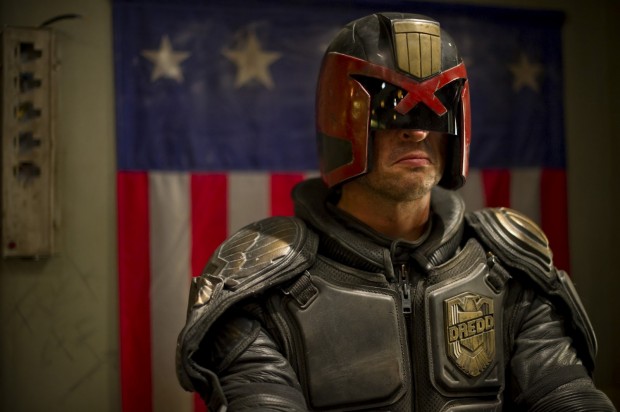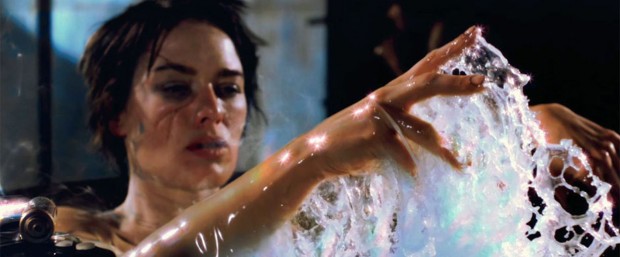You have no items in your cart. Want to get some nice things?
Go shoppingIn Science Fiction, style really is everything.

“Citizen Ma-Ma, your crimes include multiple homicide and the manufacture and distribution of illegal narcotics. How do you plead?” Ma-Ma stares back, deadpan, inhaling the residue Slow-Mo vapour defiantly. Her eyes sparkle like a cat’s as the drug sets to work. “Defence noted,” Dredd growls.With a merciless shove, Ma-Ma is sent crashing through the glass panel and hurtles two hundred stories to her death. The subsequent two-minute long sequence can only be described as beautiful; high speed cameras and underwater cinematography were employed to create a visual feat that makes Lena Headey look like a fallen angel plummeting to hell. Ambient music accompanies her descent. She watches each level fly past in slow, detailed horror, a bloody reminder of her crimes before she finally touches down, the screen filling with red as her face splits asunder. Back on the top floor, Dredd merely looks on, turns his back, and mutters a single word; “Yeah.”
For me, this scene represented everything special about Pete Travis’s adaptation of the 2000AD Judge Dredd comics, a film that was far better than it had any right to be. It defies everything we have come to expect from a remake, asks us to completely ignore its Stallone-starring, campy predecessor without even a wink thrown the audience’s way. This vision of a dystopian ‘Mega-City’ housing eight hundred million people is grimy, grungy and cathartically violent and gives us a sci-fi the likes of which we haven’t seen since perhaps 1987’s Robocop. Why do these films work? Science fiction on screen can sometimes get lost in its own unrealistic sheen, worlds we’ll probably never have to consider in any greater detail. But Robocop? Set in a corrupt neo-capitalist society where media moguls own the police. Dredd? A post-nuclear fallout earth where a severe population crisis breeds poverty and crime in gargantuan concrete tower blocks. Try telling yourself it will never happen.
One of the most intelligent choices of Dredd’s creators was to make it 18-certificated, and unashamedly so. The style takes precedence and violence plays a very important role. It is what drives the three main characters; one struggles to come to terms with it, one uses it in the name of justice and one uses it for power. There could never really have been any other choice and it gave Pete Travis a massive canvas with which to paint an incredibly well formulated world. And in science fiction, that should always be the primary goal. The most iconic sci-fi films of the past one hundred years never compromised in this: Blade Runner, 2001, Metropolis, none of them were afraid to redefine audience expectations at the cost of potentially losing out at the box office. In fact, some of them did and Dredd isn’t exempt from this, although it suffered more from poor marketing as opposed to audiences ‘not getting’ what it was trying to say. As a result, Dredd cuts its own personality in to every minute and every frame of its duration, putting it up there with the greats. Who would have thought that a movie based on a comic book could achieve such heights? No wonder it spawned an on-line movement of cult fans looking to get the ball rolling on a sequel. They may be in for a wait, however.

Dredd reminds us that 3D in film has come a long way, even if film-makers still don’t understand how to utilise it correctly. Science fiction perhaps has the biggest license to use it, not least because it was developed for that very purpose via the most expensive sci-fi ever made, James Cameron’s Avatar. There it was used to expand un-reality and to good effect, and only in that way has it ever really made sense. How is any other film made better for its inclusion, especially when it is layered as an afterthought in post-production? It’s a technology that needs proper handling, not to be used just for adding a few quid on to an already expensive cinema ticket. 3D was in Dredd’s release title: were you afraid? I was. I had yet to see a balance between clever use of this new fad and clever film-making – sorry, James Cameron – and my hopes for discovering this lost piece to the 3D puzzle over the course of the next 95 minutes were low. Wow, was I wrong. Here, I witnessed the benchmark and other film makers need to take note. From the comic book camera angles, the oily surface of the Mega-Block’s metallic structure to the signature euphoric ‘Slow-Mo’ scenes that sparkle all around us, it added depth, character and was carefully crafted to seamlessly blend story and style.
Indeed, the entire production design was a masterpiece. It very much felt grounded in reality, albeit one centred around the devastation of war and civil unrest. The focus was on the extremes that the world had been pushed to as a consequence, the future highlighted through situation as opposed to complicated technologies and pseudo-science. Given, Dredd offers us advanced firearms with numerous combative settings and his rookie partner is psychic, but these all remain a part of the dynamic, never bogged down with too much exposition. Instead, Dredd examines how the world would need to adapt in the face of over-population and a lack of basic resources; without too much of the film spent pondering this, it’s so organically created that we just…understand. The rest of the flavour comes from the distinct punk vibe to the locations and the characters, like time stopped around the 80’s. The cars run on wheels, the tech seems almost archaic in our modern age of tablets and miniaturisation. On the outside, earth has expanded, but on the inside, it has regressed, like it bit off way more than it could chew. It reminded me of when I once visited Cairo some years back, a city that felt like it was trying to catch up with the rest of the developed world. There was a feeling of a sleeping chaos that could erupt at any moment, (indeed, not long after it actually did,) that for me Dredd seemed to capture.
This one-off achieved a lot more with a smaller budget and a much simpler premise than many of the more recent blockbusters within the genre. The future is portrayed as desperate as opposed to advanced, bloated and threatening and hanging in the balance, a balance maintained by the Judges. What little we see of it is frightening. But if Dredd has taught us anything two years on, is that audiences are ready to pass through the doorway Travis opened for us, a doorway back in time to a place where film-makers were unafraid, where certificate-18 films existed and characters like Dredd and Ma-Ma would become pulp idols.
A simpler time. A cooler time.
Jake Munn’s review of Dredd kicks off Litro’s look at Future Fashions in film.

About Jake Munn
Jake Munn tutors media at an alternative learning provision in Hertfordshire by day and directs short and corporate films by night. He fits writing fiction in between. Favourite film - The Good, The Bad and The Ugly.




